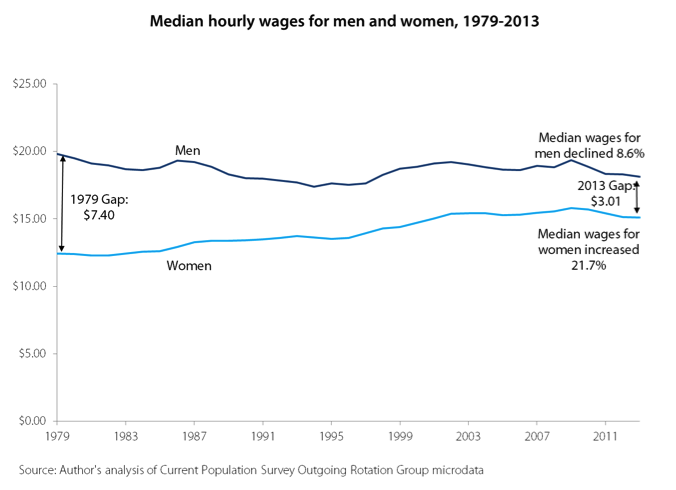Fixing the Gender Wage Gap Is a Crucial Step for Women, But Not the Only Step
The Atlantic’s Derek Thompson wrote a great review of Claudia Goldin’s latest work on closing the wage gap at the upper level of the distribution. Goldin postulates that the final steps to closing the gender wage gap begin at the top rungs of the income distribution. Goldin examines MBA graduates’ earnings over their life span, and finds that the wage gap would start to close if firms didn’t have an incentive to disproportionately reward individuals “who worked long hours and who worked particular hours.” Men may be more able to choose to work long hours in a way that women, particularly in their first 10-15 years of work, may not choose to do for any number of reasons (most obviously: having kids), and whoever is willing to work these longer hours (usually men) gets disproportionately rewarded. To close the gap, Goldin calls for changes to the way jobs are structured—in short, greater work time flexibility.
While Goldin’s analysis is currently my favorite analysis for understanding gender wage inequality at the top—and I applaud her call to give high wage professionals more autonomy and encourage more flexible work schedules—her analysis doesn’t solve the question of how to close the wage gap for the majority of American workers, those who earn low- and middle-wages. (I’m also skeptical of the idea that there aren’t substantial incentives among those in power to keep the structure of high wage professions as it is or that work time flexibility will be enforced by companies even if it’s created.) For the majority of women, gender wage gaps are one way that women get the raw deal, but it is not the only way.
The graph below shows this phenomenon by using the median—or typical hourly—wage for men and women. Women at the median grew from making 62.7 percent of what men were making in 1979 to 83.4 percent in 2013; however, much of this convergence was not the “good” kind. A significant portion of the improvement in the gender wage gap occurred because men lost ground rather than because women gained ground. Wages for men fell by 8.6 percent, whereas wages for women increased by 21.7 percent. Closing the wage gap by decreasing wages for men is not the type of improvement that actually helps women (and certainly doesn’t help men).
There exists a notion among some that the bad economic outcomes men have experienced over the last four decades are linked to women’s economic gains. If this were true, women’s wages would have grown at the same pace as overall productivity growth, but that didn’t happen. Between 1979 and 2013, productivity increased 75.6 percent, over three times as much as women’s wage growth of 21.7 percent and obviously higher than men’s decrease in wage growth.
Other forces are clearly at play. Both men and women have experienced depressed wages due to the erosion of labor standards and institutions, lopsided globalization, the shift of economic rents to corporate executives and financial professionals, and the lack of full employment. The phenomenon truly is the result of rising wage inequality for both men and women over this period. Women’s countervailing gains in labor force attachment, educational attainment, and occupational upgrading have worked however, to offset those forces. Most of the wage gains were going to the already affluent, not to middle- or low-wage workers. Wages for women in the 95th percentile increased 69.9 percent (relative to the wage increase of the median woman of 21.7 percent) and wages for men in the 95th percentile increased by 40 percent over the period (while the median wage for men declined). While women at the top need to fight for work flexibility, for the vast majority of women, the need to fight inequality is equally pressing.
Enjoyed this post?
Sign up for EPI's newsletter so you never miss our research and insights on ways to make the economy work better for everyone.
